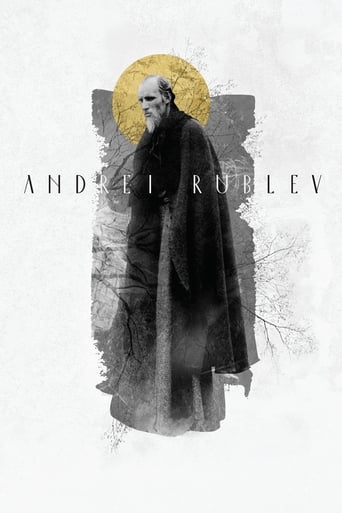タルコフスキーとコンチャロフスキーという、旧ソ連の枠を脱して活躍することになる二大俊英が協力して脚本を執筆し、中世ロシア史上最高のイコン画家ルブリョフを主人公に、当時の社会と民衆の関わりを巨視的に捉えた歴史大作で、全体で二部構成。冒頭の、巨大な気球での飛行を試みる男たちの描写が象徴する閉鎖的な時代に、信仰と芸術の力によって風穴を開けたのがルブリョフと言える。彼は同窓の僧侶キリールに陥れられかけ、逆に大公の覚えめでたく宮廷画家となるが、連日、寺院の白い壁に向かい一筆も動かさない。神の愛を描きたいと願う彼の眼に時代は暗く映りすぎた。そして、公弟にそそのかされたタタール人が城を襲う(ここからが第二部)。ルブリョフは白痴の少女を救おうとして敵兵を討ち、後悔から筆を絶ち、修道院に戻るが、誰とも口をきかない。今や落魄の身のキリールとの再会……。ロシアはなお暗黒の中にあったが、大公は巨大な鐘の鋳造で威信回復を図る。今はなき名人の息子ボリースカの指導によって作業は開始され、ルブリョフはそれを興味深く見守る。秘訣を父に教わったという少年だが、実は鐘を作りたいばかりについた出まかせで、ようやく大鐘完成の暁に彼は真実を泣きながらルブリョフに明かす。彼は少年を賞賛し、自らも励まして言った。“君と一緒にやって行こう”……。15年にわたる無言の行の末、最初に出た言葉がそれであった。彼は再び絵筆をとり、その後、それまでの白黒とうって変わった鮮やかなカラーで写し出される偉大な作品群を残したのである。観ることが主人公の忍従に重なるような重厚な作品だが、それ故にラストの解放感は筆舌に尽くし難い。丸裸の自己と神--という一対一の構図を発見するまでの確執を描くのは、後のタルコフスキー作品にも通じるテーマだ。
"Андрей Рублёв" (1966), a cinematic masterpiece directed by Andrei Tarkovsky and produced by Mosfilm and Tvorcheskoe Obedinienie Pisateley i Kinorabotnikov in the Soviet Union, is a profound exploration of the life and times of the iconic 15th-century Russian icon painter, Andrei Rublev. The film delves deep into the spiritual and existential struggles of its protagonist, set against the backdrop of medieval Russia's tumultuous socio-political landscape. Tarkovsky's visionary approach to storytelling, characterized by long, contemplative shots and a non-linear narrative, invites viewers to immerse themselves in the inner world of Rublev, as he grapples with the violence and chaos around him, ultimately finding solace and purpose in his art. The film's visual language is as striking as its thematic depth, with each frame meticulously crafted to evoke the essence of medieval Russia. From the stark, monochromatic scenes that dominate much of the film to the vibrant, almost otherworldly colors of Rublev's icons, Tarkovsky masterfully uses cinematography to mirror the protagonist's journey from despair to enlightenment. The film's pacing, often slow and deliberate, allows for a meditative experience that encourages viewers to reflect on the broader implications of Rublev's struggles, such as the role of art in times of crisis and the enduring quest for meaning amidst suffering. "Andrey Rublev" also stands out for its unflinching portrayal of the brutality and corruption that plagued medieval Russia, challenging the romanticized notions of the period often found in historical narratives. The film does not shy away from depicting the harsh realities faced by its characters, including scenes of violence and oppression that underscore the film's central themes of faith, redemption, and the human condition. Through these depictions, Tarkovsky invites a critical examination of the past, urging viewers to consider how history's lessons can inform our understanding of the present. Despite facing significant censorship and controversy upon its release, "Андрей Рублёв" has since been recognized as a landmark achievement in world cinema, celebrated for its artistic innovation and philosophical richness. The film's enduring legacy lies in its ability to transcend time and place, offering a timeless meditation on the power of creativity and the resilience of the human spirit. As such, "Андрей Рублёв" remains a testament to Tarkovsky's genius and a poignant reminder of the transformative potential of art.
年1966
上映時間205 分
収益24173$
オンラインで見る
ジャンルドラマ履歴
製作国Soviet Union

